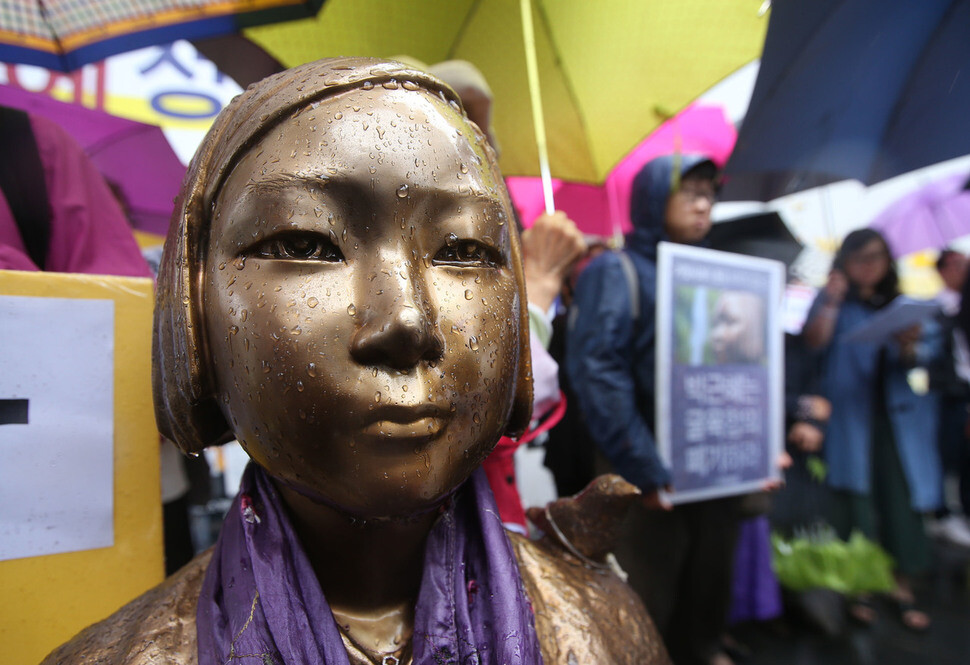hankyoreh
Links to other country sites 다른 나라 사이트 링크
[Editorial] Statue should not be central concern of comfort women issue

On exactly two occasions, the issue of the comfort woman statue has been brought up in a summit between South Korea and Japan. The first time was the summit between former South Korean President Lee Myung-bak and Japanese Prime Minister Yoshihiko Noda held in Kyoto in Dec. 2011 that broke down over the comfort women issue. The second time was the most recent summit between South Korean President Park Geun-hye and Japanese Prime Minister Shinzo Abe that was held in Vientiane, the capital of Laos, on Sept. 8. But the ways and circumstances in which the comfort woman statue was broached at these two meetings were completely different.
During the summit in Kyoto, Noda abruptly brought up the idea of removing the comfort woman statue that stands in front of the Japanese Embassy in Seoul as a defensive reaction after Lee called upon Japan to take action to resolve the comfort women issue. During the summit meeting in Vientiane, however, Abe was the first to bring up the comfort woman statue, and he aggressively pressed for its removal.
The key point for Japan is that since it has completed the 1 billion yen (US$9.8 million) payment in keeping with the comfort women agreement reached on Dec. 28, 2015, it wants the South Korean government to also make an effort to faithfully implement its side of the agreement, which would include dealing with the comfort woman statue.
The Blue House stated that it would not be appropriate to confirm the comments made by Prime Minister Abe and that President Park had not mentioned the comfort woman statue.
The Japanese say that when Park mentioned “faithfully implementing the agreement” during the summit, they “naturally assumed that this was a response to the remarks that Prime Minister Abe had made about the comfort woman statue.” This certainly makes the Blue House’s explanation sound lame.
One fact that can be clearly deduced from the Blue House’s explanation is that Park did not explicitly rebut Abe’s comments about the comfort woman statue. No wonder that people suspect that there was a secret deal to swap the 1 billion yen (US$9.8 million) for the removal of the statue.
This bizarre reversal – with the main issue of the comfort women being pushed to the side and the peripheral issue of the comfort woman statue coming to the fore – is a humiliating consequence of using imperfect and inappropriate methods to reach a political compromise while disregarding the crux of the issue, which is demanding that Japan clearly take legal responsibility for its actions. It is also a failure of foreign policy on the comfort women issue, which has made it necessary to hastily arrange a political compromise while ignoring the security situation on and around the Korean Peninsula.
As we have seen with this summit, the Japanese are going to keep stubbornly asking for the removal of the comfort woman statue now that they have claimed the “moral high ground” by completing the payment of the 1 billion yen (US$9.8 million). The only way for South Korea to put an end to this humiliation is unfortunately to start over from scratch on the comfort women issue.
Please direct questions or comments to [english@hani.co.kr]

Editorial・opinion
![[Editorial] Perilous stakes of Trump’s rhetoric around US troop pullout from Korea [Editorial] Perilous stakes of Trump’s rhetoric around US troop pullout from Korea](https://flexible.img.hani.co.kr/flexible/normal/500/300/imgdb/original/2024/0509/221715238827911.jpg) [Editorial] Perilous stakes of Trump’s rhetoric around US troop pullout from Korea
[Editorial] Perilous stakes of Trump’s rhetoric around US troop pullout from Korea![[Guest essay] Preventing Korean Peninsula from becoming front line of new cold war [Guest essay] Preventing Korean Peninsula from becoming front line of new cold war](https://flexible.img.hani.co.kr/flexible/normal/500/300/imgdb/original/2024/0507/7217150679227807.jpg) [Guest essay] Preventing Korean Peninsula from becoming front line of new cold war
[Guest essay] Preventing Korean Peninsula from becoming front line of new cold war- [Column] The state is back — but is it in business?
- [Column] Life on our Trisolaris
- [Editorial] Penalties for airing allegations against Korea’s first lady endanger free press
- [Editorial] Yoon must halt procurement of SM-3 interceptor missiles
- [Guest essay] Maybe Korea’s rapid population decline is an opportunity, not a crisis
- [Column] Can Yoon steer diplomacy with Russia, China back on track?
- [Column] Season 2 of special prosecutor probe may be coming to Korea soon
- [Column] Park Geun-hye déjà vu in Yoon Suk-yeol
Most viewed articles
- 1Korea likely to shave off 1 trillion won from Indonesia’s KF-21 contribution price tag
- 2Nuclear South Korea? The hidden implication of hints at US troop withdrawal
- 3[Editorial] Perilous stakes of Trump’s rhetoric around US troop pullout from Korea
- 4With Naver’s inside director at Line gone, buyout negotiations appear to be well underway
- 5In Yoon’s Korea, a government ‘of, by and for prosecutors,’ says civic group
- 6[Column] ‘Choson’: Is it time we start referring to N. Korea in its own terms?
- 7‘Free Palestine!’: Anti-war protest wave comes to Korean campuses
- 8How many more children like Hind Rajab must die by Israel’s hand?
- 9Overseeing ‘super-large’ rocket drill, Kim Jong-un calls for bolstered war deterrence
- 10[Photo] ‘End the genocide in Gaza’: Students in Korea join global anti-war protest wave